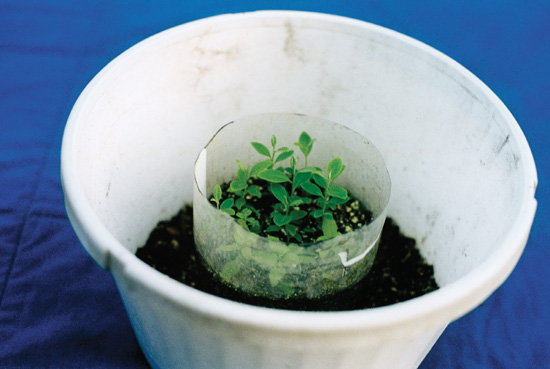JARS v55n3 - Making Your Own Hormone Paste
Making Your Own Hormone Paste
Dr. Mark Konrad
Sewickley, Pennsylvania
There is at least one source of rooting hormone paste that is available commercially. Carolina Biological Supply Company, Burlington, North Carolina, offers the following products. Both IAA and IBA are supplied in a lanolin base, 500 and 5000 parts per million strengths. It can be ordered through 1-800-334-5551; however, a business identification is needed.
There is much to recommend using a paste since there is more certainty of holding the hormone in place at the rooting site.
For no other reason than convenience, I decided to experiment with making my own paste. K-Y jelly seemed to be a good product to start with because of its water solubility. It is used in various medical examinations for the lubricating quality. It can be purchased in pharmacies and many supermarket outlets. A generic form is also available.
The easiest way to prepare the paste is to spread the jelly on plastic sheeting and mix in the hormone powder. The resulting slurry is easily applied to the cutting and adheres well. Either a small or large amount of the paste can be mixed depending on the need.
My first experimentation was with tip cuttings from new growth of recently rooted lepidotes (R. 'April Snow'). Small containers were used with covers of thin plastic held in place with a rubber band. The medium was composed of equal parts of a seedling mix (finely screened Canadian peat and vermiculite) and perlite. After application of the hormone paste, the cuttings were placed under eighteen hours per day fluorescent lighting. Hand misting on the underside of the plastic allowed for near 100 percent humidity.
Results
The early results are quite encouraging. Before the end of the first month rooting had taken place and terminal growth had begun. At this point the container was placed in a white hanging basket pot with clear plastic lightly placed over the top. Hand misting with a very dilute fertilizer solution was also started at this time (Liquid Miracle Gro for African Violets, one drop for each 4 oz of water). At the end of forty-five days, the cuttings had grown nearly inch and extended to the brim of the rooting container (see Figure 1).

|
|---|
Seedlings grown with the use of hormone paste. Photo by Mark Konrad |
From previous experience, the juvenile status of the cuttings has been a significant factor in reduced rooting time. The exact influence of this method, therefore, is difficult to interpret. I'm also wondering whether other emollients or emulsions (some medical) could be just as effective as the jelly.
Literature
Wada, Koichiro, 1975. Propagation by very soft-wood cuttings of rhododendrons. Quart. Bull. ARS, April 1975, Vol. 29, No. 2.
Dr. Konrad is a member of the Great Lakes Chapter and frequently contributes to the Journal on his experiments in propagation.

